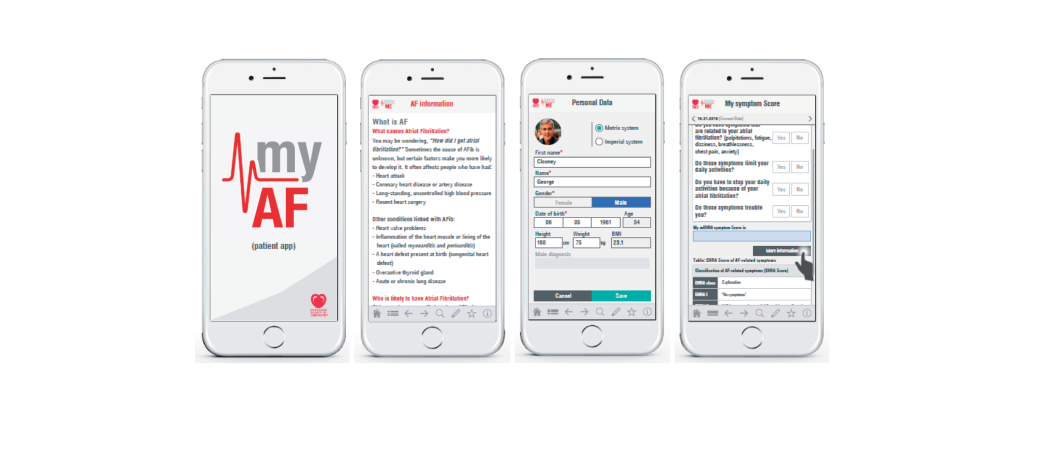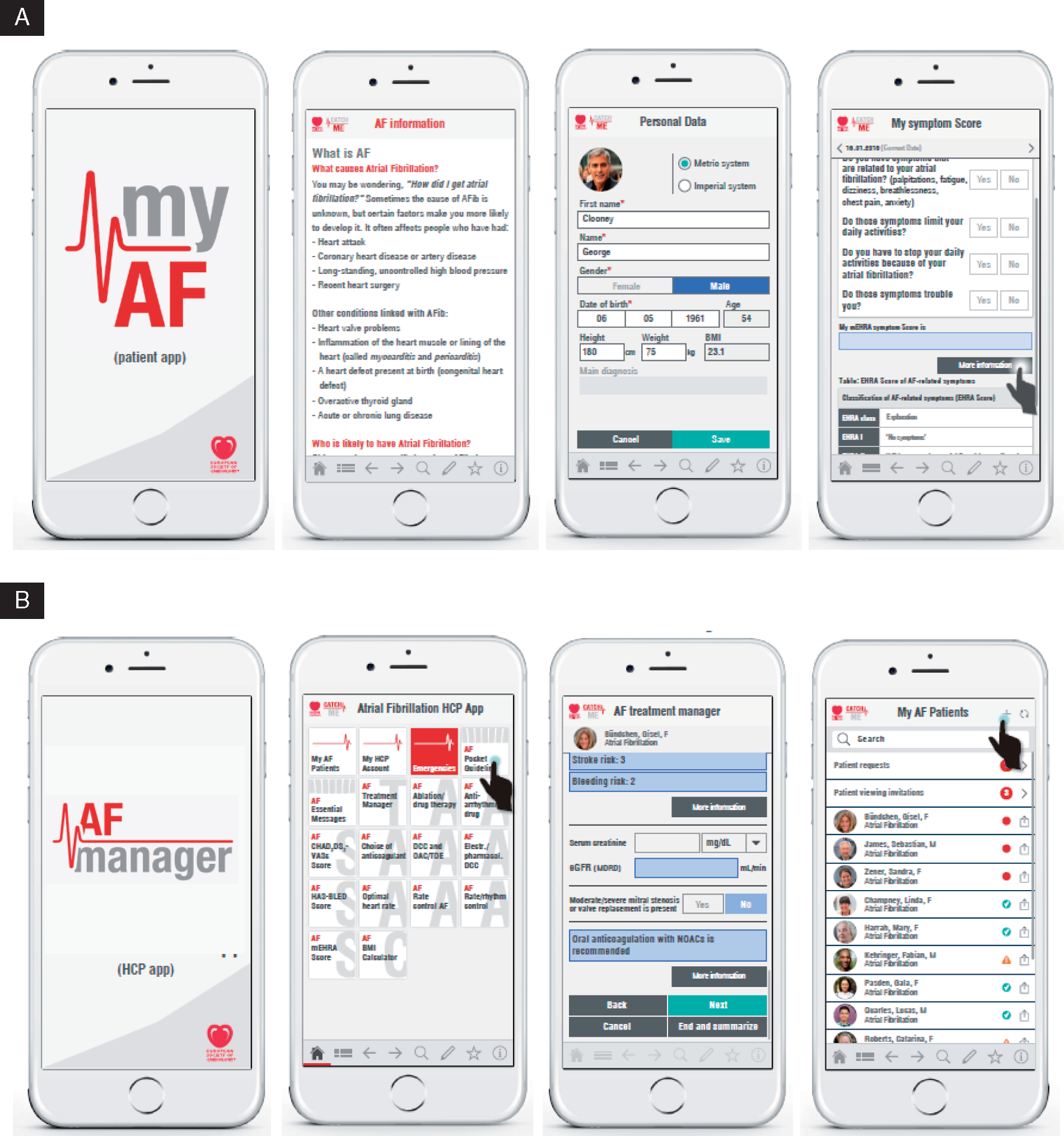The apps will improve self-care, adherence to therapy and long-term outcomes in this common, chronic condition, its developers say. The app for healthcare professionals will be one of the first such m-health apps to be CE-approved

Screenshots of the patient app
EU-funded smartphone and tablet apps for healthcare professionals and patient self-monitoring of atrial fibrillation, the most common heart rhythm disorder, were launched earlier this month.
Atrial fibrillation significantly increases the risk of stroke and death. One in four middle-aged adults in Europe and the US will develop the problem and its incidence and prevalence are rising.
“Around two-thirds of people in Europe and the US have a mobile device and use it as their main way of accessing online information,” said one of the researchers involved in the project, Dipak Kotecha, a clinician scientist in cardiovascular medicine at the Institute of Cardiovascular Sciences, Birmingham University. “This presents a big opportunity to improve self-management and shared decision making in atrial fibrillation.”
The My AF app and AF Manager app were designed by a European Society of Cardiology (ESC) task force on atrial fibrillation and the EU-funded CATCH ME (Characterising Atrial fibrillation by Translating its Causes into Health Modifiers in the Elderly) consortium.
The apps, which were developed over the last two years in tandem with the writing of the 2016 ESC’s guideline on atrial fibrillation, are freely available for Android and iOS devices through the Google Play and Apple stores.
The guidelines:
- The 2016 European Society of Cardiology (ESC) guidelines on atrial fibrillation recommend patient-centred care and an integrated, multidisciplinary treatment approach.
- Smartphone and tablet apps can provide education, encourage behaviour change, and increase treatment adherence in patients and deliver interactive treatment algorithms to aid clinicians.
- The patient app aims to enhance patient education on atrial fibrillation, self-management, and shared decision-making.
- The health care professional app is designed around the 2016 ESC guidelines on atrial fibrillation to simplify the choice of treatment and optimise guideline adherence.
The apps
My AF, for patients with atrial fibrillation, provides information about the condition, the risk of stroke, atrial fibrillation treatments, and tips on improving lifestyle. Patients can record symptoms and quality of life in a diary which can be shared with a nominated health professional before each consultation to maximise face-to-face time.
My AF was developed in collaboration with patients and patient support groups. It provides high quality information in a simple format and is suitable for adults of all ages. Work is underway to translate the app into several languages.
“The app aims to encourage active patient involvement in the management of their condition,” Kotecha said. “There is evidence that patient education can improve self-care, adherence to therapy, and long-term outcomes.”
For patients who consent to the use of data for research purposes, anonymised data will be saved for future research on symptomatology, treatment patterns, and adherence to treatment guidelines. “This is an unparalleled capability, allowing us to collate information on patients with AF across all communities, including primary practice and hospital clinics,” Kotecha said.
“Understanding the barriers to effective guideline implementation will help to improve future guidelines on AF and make them more relevant to patient care,” he said.
Meanwhile, the AF Manager app is for use by doctors, nurses and other healthcare professionals. It is the first app of its kind to be submitted for CE certification and is in the final stages of approval.
AF Manager imports information shared by the patient and allows the healthcare professional to amend details and enter other medical information, such as electrocardiogram or echocardiography data. The treatment manager tool within the app then suggests individualised treatment options based on ESC guidelines.
After a consultation, the notes, treatment decisions, and medication dosages can be entered and then shared with the patient.
“Many studies have shown that when clinicians follow guideline recommendations, patients have better outcomes,” said Kotecha. “All of the decision aids in AF Manager are based on ESC guidelines so we hope this will encourage guideline implementation. Patients will have the option to anonymously donate their data which will enable us to assess the guideline adherence rate.”
The apps are linked to allow transfer of data between patients and healthcare professionals via a secure server at Birmingham University. Patients control who can view and edit their data. When data sharing is enabled, updates are synced on both apps. All shared information is encrypted and password protected.
“We know that effective management of atrial fibrillation is suited to shared decision making and we have created the apps in the hope of facilitating this process,” said Kotecha. “Sharing information should save clinicians time and enable them to devote consultations to choosing the best treatments.”
“The dynamic nature of this technology will allow us to modify and update the features and content to reflect feedback from users, as well as future versions of the ESC atrial fibrillation guidelines,” Kotecha said.
European Society of Cardiology (ESC) smartphone and tablet applications for patients with atrial fibrillation and their healthcare providers. EP Europace. 2017. DOI: 10.1093/europace/eux299 https://academic.oup.com/europace/article-lookup/doi/10.1093/europace/eux299
 Screenshots of the patient app (A) and the health care professional app (B). Both apps available free of charge for Android and iOS through the Google Play, Amazon, and Apple stores. The standalone AF treatment manager can also be accessed through the ESC Pocket Guidelines app (AF section). All names displayed in the figure are fictitious.
Screenshots of the patient app (A) and the health care professional app (B). Both apps available free of charge for Android and iOS through the Google Play, Amazon, and Apple stores. The standalone AF treatment manager can also be accessed through the ESC Pocket Guidelines app (AF section). All names displayed in the figure are fictitious.